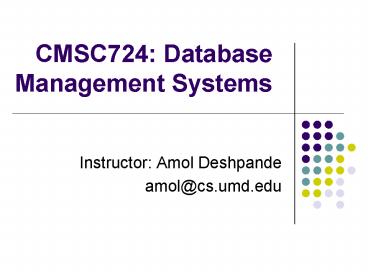CMSC724: Database Management Systems - PowerPoint PPT Presentation
1 / 13
Title:
CMSC724: Database Management Systems
Description:
'Halloween' problem. Access Methods. B -Tree and heap files. Multi-dimensional indexes not common ... More importantly, cheapest plan orders of magnitude ... – PowerPoint PPT presentation
Number of Views:27
Avg rating:3.0/5.0
Title: CMSC724: Database Management Systems
1
CMSC724 Database Management Systems
- Instructor Amol Deshpande
- amol_at_cs.umd.edu
2
Query Processing
- Assume single-user, single-threaded
- Concurrency managed by lower layers
- Steps
- Parsing attritube references, syntax etc
- Catalog stored as denormalized tables
- Rewriting
- Views, constants, logical rewrites (transitive
predicates, true/false predicates), semantic
(using constraints), subquery flattening
3
Query Processing
- Steps
- Optimizer
- Executor
- get_next() iterator model
- Narrow interface between iterators
- Can be implemented independently
- Assumes no-blocking-I/O
- Some low-level details
- Tuple-descriptors
- Very carefully allocated memory slots
- avoid in-memory copies
- Pin and unpin
4
Query Processing
- SQL Update/Delete
- Halloween problem
- Access Methods
- B-Tree and heap files
- Multi-dimensional indexes not common
- init(SARG)
- avoid too many back-and-forth function calls
- Allow access by RID
5
Query Optimization
- Goal Given a SQL query, find the best physical
operator tree to execute the query - Problems
- Huge plan space
- More importantly, cheapest plan orders of
magnitude cheaper than worst plans - Typical compromise avoid really bad plans
- Complex operators/semantics etc
- (R outerjoin S) join T ? R outerjoin (S join T)
6
Query Optimization
- Heuristical approaches
- Perform selection early (reduce number of tuples)
- Perform projection early (reduce number of
attributes) - Perform most restrictive selection and join
operations before other similar operations. - Dont do Cartesian products
- INGRES
- Always use NL-Join (indexed inner when possible)
- Order relations from smallest to biggest
7
Query Optimization
- A systematic approach
- Define plan space
- A cost estimation technique
- An enumeration algorithm to search through the
space
8
System-R Query Optimizer
- Define plan space
- Left-deep plans, no Cartesian products
- Nested-loops and sort-merge joins, sequential
scans or index scans - A cost estimation technique
- Use statistics (e.g. size of index, max, min etc)
or magic numbers - Formulas for computing the costs
- An enumeration algorithm to search through the
space - Dynamic programming
9
System-R Query Optimizer
- Dynamic programming
- Uses principle of optimality
- Bottom-up algorithm
- Compute the optimal plan(s) for each k-way join,
k 1, , n - Only O(2n) instead of O(n!)
- Computers plans for different interesting
orders - Extended to physical properties later
- Another way to look at it
- Plans are not comparable if they produce results
in different orders - An instance of multi-criteria optimization
10
Since then
- Search space
- Bushy plans (especially useful for
parallelization) - Cartesian products (star queries in data
warehouses) - Algebraic transformations
- Can group by and join commute ?
- More physical operators
- Hash joins, semi-joins (crucial for distributed
systems) - Sub-query flattening, merging views
- Query rewrite
- Parallel/distributed scenarios
11
Since then
- Statistics and cost estimation
- Optimization only as good as cost estimates
- Histograms, sampling commonly used
- Correlations ?
- Ex where model accord and make honda
- Say both have selectivities 0.0001
- Then combined selectivity is also 0.0001, not
0.0000001 - Learning from previous executions
- Learning optimizer (LEO_at_IBM), SITS (MS SQL
Server) - Cost metric
- Response time in parallel databases, buffer
utilization
12
Since then
- Enumeration techniques
- Bottom-up more common
- Easier to implement, low memory footprint
- Top-down (Volcano/Cascades/SQL Server)
- More extensible, typically larger memory
footprint etc... - Neither work for large number of tables
- Randomized, genetic etc
- More common to use heuristics instead
- Parametric query optimization
13
Other issues
- Non-centralized environments
- Distributed/parallel, P2P
- Data streams, web services
- Sensor networks??
- User-defined functions
- Materialized views































